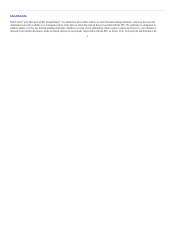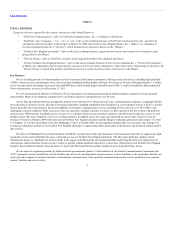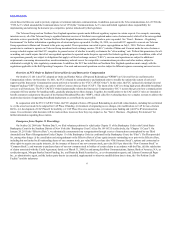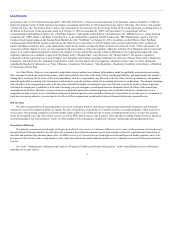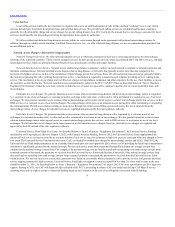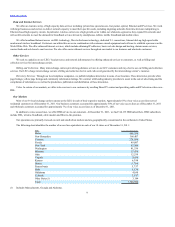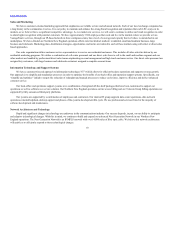FairPoint Communications 2011 Annual Report Download - page 15
Download and view the complete annual report
Please find page 15 of the 2011 FairPoint Communications annual report below. You can navigate through the pages in the report by either clicking on the pages listed below, or by using the keyword search tool below to find specific information within the annual report.
Table of Contents
FCC New Rules for Intercarrier Compensation Overview
The FCC CAF/ICC Order establishes rules to reform historical rules associated with local, state toll and interstate toll traffic exchanged among
communications carriers including ILECs, CLECs, cable companies, wireless carriers and VoIP providers. The new rules, the majority of which are effective
beginning July 1, 2012, establish separate rules for price cap carriers and rate-of-return carriers. Although the FCC order treats our rate-of-return carriers
(including companies operating under average schedules) as price cap carriers for CAF funding, it treats them as rate-of-return carriers for purposes of ICC
reform. For both price cap and rate-of-return carriers the FCC establishes a multi-year transition of terminating traffic compensation to “bill and keep”, or zero
compensation. For both price cap and rate-of-return carriers, the FCC requires carriers to establish fiscal year 2011 (“FY2011”) baseline compensation, which
is the amount of relevant compensation billed during the period beginning October 1, 2010 and ending September 30, 2011, and collected by March 31, 2012.
This FY2011 revenue is used as a starting point for revenue for the transitional period, which is six years for price cap operations and nine years for rate-of-
return operations. For each operation, the FY2011 baseline revenue is reduced by a specified percent during each year of the transition, resulting in a target
revenue for each tariff year. At the same time, the FCC rules require reductions in ICC rates for specified services and jurisdictions. As the recoverable revenue
declines and the rates decline, any target revenue which will not be covered by ICC revenue can be recovered, in part, from end users through an access
recovery charge (“ARC”). Price cap incumbent LECs are permitted to implement monthly end user ARCs with five annual increases of no more than $0.50 for
residential/single-line business consumers, for a total monthly ARC of no more than $2.50 in the fifth year; and $1.00 (per month) per line for multi-line
business customers, for a total of $5.00 per line in the fifth year, provided that: (1) any such residential increases would not result in regulated residential end-
user rates that exceed the $30 residential rate ceiling; and (2) any multi-line business customer’s total subscriber line charge (“SLC”) plus ARC does not exceed
$12.20. Rate-of-return incumbent LECs are permitted to implement monthly end user ARCs with six annual increases of no more than $0.50 (per month) for
residential/single-line business consumers, for a total ARC of no more than $3.00 in the sixth year; and $1.00 (per month) per line for multi-line business
customers for a total of $6.00 per line in the sixth year, provided that: (1) such increases would not result in regulated residential end-user rates that exceed the
$30 Residential Rate Ceiling; and (2) any multi-line business customer’s total SLC plus ARC does not exceed $12.20. If the combination of ICC and ARC
revenue is not sufficient to cover the targeted revenue, then additional funding will be provided by the CAF.
Interstate Access Charges
Our local exchange subsidiaries receive compensation from long-distance telecommunications providers for the use of their network to originate and
terminate interstate inter-exchange traffic. With respect to interstate traffic, the FCC regulates the prices we may charge for this purpose, referred to as access
charges, as a combination of flat monthly charges paid by end-users, usage-sensitive charges paid by long-distance carriers, and recurring monthly charges
for use of dedicated facilities paid by long-distance carriers. The amount of access charge revenue that we will receive is subject to change. As previously
described, the FCC has adopted a plan to resolve certain billing disputes related to intercarrier compensation and to transition all terminating state and
interstate intercarrier compensation to zero over a six or nine year period for price cap and rate-of-return companies, respectively.
Our ILEC operations in Maine, New Hampshire and Vermont and, effective July 1, 2010, our Telecom Group operations in Maine and Vermont, are
subject to price cap regulation of access charges. Under price cap regulation, limits are imposed on a company’s interstate rates without regard to its costs or
revenue requirements. These limits are adjusted annually based on FCC-specified formulae, such as for inflation, as well as through occasional regulatory
proceedings, but will generally give us flexibility to adjust our rates within these limits. In contrast, our rural operations are subject to interstate rate-of-return
regulation, permitting us to set rates for those operations based upon our allowed costs and projected revenue requirement, including an authorized rate-of-
return of 11.25%. In an order dated January 25, 2008, the FCC granted our request for a waiver of the “all or nothing” rule, which allows us to continue to
operate under both of these regimes until the FCC completes its general review of whether to modify or eliminate the all or nothing rule, or makes other
comprehensive changes to its access charge rules. As previously discussed, the state and interstate terminating switched access rates for our rate-of-return
regulated ILECs are impacted by the FCC CAF/ICC Order, which establishes a transition of these rates to zero over nine years. During this transition these
rates will no longer be based on costs but will be subject to a complex transition mechanism established by the FCC.
The FCC CAF/ICC Order significantly changes the existing rates for access charges, which, combined with the development of competition, have
generally caused the aggregate amount of switched access charges paid by long-distance carriers to decrease over time. The FCC also is considering whether to
modify price cap rules as they apply to special access and whether to restrict some of the pricing flexibility enjoyed by price cap ILECs, which includes some
of our Northern New England operations. We cannot predict what changes, if any, the FCC may eventually adopt and the effect that any of these changes may
have on our business.
14


